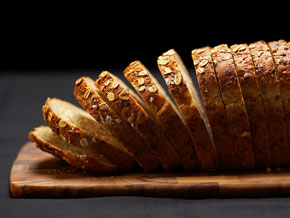Behold! The Health Benefits of Whole Wheat Bread

Photo: © 2009 Jupiterimages Corporation
The benefits of 100 percent whole grains are piling up fast—and so are the number of products touting whole grains on their labels. The trouble? Labels don't always present an accurate picture of what's inside, and the product that appears to be good for you on the label may have all the nutritional goodness of a gum wrapper.
Why do you want whole grains? They contain the bran and the germ of the grain, which have more nutrients than the endosperm—those are the real names; we didn't make them up—that you get with refined or enriched grains. Whole grains are absorbed more slowly than foods made from enriched or bleached flour, so they raise glucose and insulin levels less and keep you feeling fuller longer.
A diet rich in whole grains may also help steer you around cardiovascular disease, metabolic syndrome, even gum disease—not to mention the pain of having to buy bigger pants.
But not all foods that tout whole grain or whole wheat provide it in the healthiest form. You want the grain to have all of its original components. Here are a few fake-out label words to watch for:
The breakfast bread that can control afternoon appetite
Why do you want whole grains? They contain the bran and the germ of the grain, which have more nutrients than the endosperm—those are the real names; we didn't make them up—that you get with refined or enriched grains. Whole grains are absorbed more slowly than foods made from enriched or bleached flour, so they raise glucose and insulin levels less and keep you feeling fuller longer.
A diet rich in whole grains may also help steer you around cardiovascular disease, metabolic syndrome, even gum disease—not to mention the pain of having to buy bigger pants.
But not all foods that tout whole grain or whole wheat provide it in the healthiest form. You want the grain to have all of its original components. Here are a few fake-out label words to watch for:
- Made with whole grains.
It may have a pinch of whole grains, but unless it's 100 percent, you won't reap most of the potential benefits. - Multigrain
This tells you nothing about whether the grains are whole or refined. Even if you're getting 38 different grains, that isn't much good if they are all refined. - Whole grain
If the label doesn't say "100 percent whole grain," it may have many grain blends. Bad words to see paired with "flour" are: "enriched," "bleached," "unbleached," "semolina," "durum" and "rice."
The breakfast bread that can control afternoon appetite



